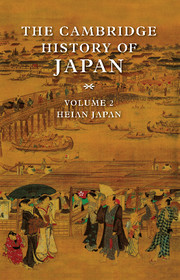Book contents
- Frontmatter
- Introduction
- 1 The Heian court, 794–1070
- 2 The capital and its society
- 3 Land and society
- 4 Provincial administration and land tenure in early Heian
- 5 Chinese learning and intellectual life
- 6 Aristocratic culture
- 7 Aristocratic Buddhism
- 8 Religious practices
- 9 Insei
- 10 The rise of the warriors
- Works cited
- Glossary-index
- Japan in the Heian period"
- References
6 - Aristocratic culture
Published online by Cambridge University Press: 28 March 2008
- Frontmatter
- Introduction
- 1 The Heian court, 794–1070
- 2 The capital and its society
- 3 Land and society
- 4 Provincial administration and land tenure in early Heian
- 5 Chinese learning and intellectual life
- 6 Aristocratic culture
- 7 Aristocratic Buddhism
- 8 Religious practices
- 9 Insei
- 10 The rise of the warriors
- Works cited
- Glossary-index
- Japan in the Heian period"
- References
Summary
The term aristocratic culture is here used to mean a style of social and artistic expression characteristic of the Japanese court at Heiankyō and limited primarily to its members. The small, isolated, tightly knit court community shared traits that conditioned the development of the culture: a strong sense of status and a firm subordination of the individual; an emphasis on order, decorum, and conformity; a greater interest in immediate solutions to practical problems than in ethical questions, philosophical speculation, or scientific inquiry; a general tendency toward emotionalism in preference to intellectualism; a pervasive, melancholy concern with the changes wrought by the passing of time; a high esteem for literature, calligraphy, and music; an acute sensitivity to beauty and to the moods of nature; and an unwavering belief in the importance of taste as an index of character and breeding. As a group, those characteristics seem to have crystallized during the last decades of the ninth century and the first half of the tenth – a period, symbolized by the cancellation in 894 of the court's last projected official mission to China, during which the Japanese repudiated earlier efforts to make their court a mirror image of the one at Ch'ang-an, and moved instead toward the amalgamation of foreign and native elements into a civilization distinctively their own.
The preoccupation with beauty, one of the most conspicuous aspects of the new culture, influenced attitudes toward nature, standards of judgment in the arts, appraisals of human worth, and norms of social behavior.
Keywords
- Type
- Chapter
- Information
- The Cambridge History of Japan , pp. 390 - 448Publisher: Cambridge University PressPrint publication year: 1999
References
- 4
- Cited by

